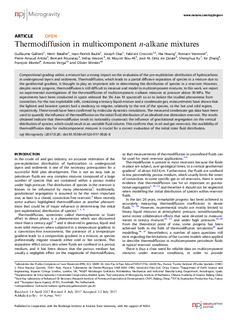Title
Thermodiffusion in multicomponent n-alkane mixturesAuthor
Author (from another institution)
Publication Date
2017Version
Published versionDocument type
Journal ArticleJournal ArticleLanguage
EnglishRights
© The Author(s) 2017Access
Open accessPublisher’s version
http://dx.doi.org/10.1038/s41526-017-0026-8Published at
npj Microgravity Published online 11 August, 2018Publisher
Nature Research (Part of Springer Nature)Abstract
Compositional grading within a mixture has a strong impact on the evaluation of the pre-exploitation distribution of hydrocarbons in underground layers and sediments. Thermodiffusion, which leads to a ... [+]
Compositional grading within a mixture has a strong impact on the evaluation of the pre-exploitation distribution of hydrocarbons in underground layers and sediments. Thermodiffusion, which leads to a partial diffusive separation of species in a mixture due to the geothermal gradient, is thought to play an important role in determining the distribution of species in a reservoir. However, despite recent progress, thermodiffusion is still difficult to measure and model in multicomponent mixtures. In this work, we report on experimental investigations of the thermodiffusion of multicomponent n-alkane mixtures at pressure above 30 MPa. The experiments have been conducted in space onboard the Shi Jian 10 spacecraft so as to isolate the studied phenomena from convection. For the two exploitable cells, containing a ternary liquid mixture and a condensate gas, measurements have shown that the lightest and heaviest species had a tendency to migrate, relatively to the rest of the species, to the hot and cold region, respectively. These trends have been confirmed by molecular dynamics simulations. The measured condensate gas data have been used to quantify the influence of thermodiffusion on the initial fluid distribution of an idealised one dimension reservoir. The results obtained indicate that thermodiffusion tends to noticeably counteract the influence of gravitational segregation on the vertical distribution of species, which could result in an unstable fluid column. This confirms that, in oil and gas reservoirs, the availability of thermodiffusion data for multicomponent mixtures is crucial for a correct evaluation of the initial state fluid distribution. [-]
xmlui.dri2xhtml.METS-1.0.item-sponsorship
This work has been supported by ESA through the SCCO project. We warmly acknowledge the contributions of QinetiQ Space (Antwerp, Belgium), Core Laboratories: Sanchez Technologies (Paris, France) and SISET (Yantai, China) for developing and building both hardware and software of the microgravity experimental set up flown on SJ-10. We also thank TOTAL S.A. and PETROCHINA for permission to publish present and past data. The Spanish teams (Mondragon Unibertsitatea and Universidad Complutense) are thankful to the TERDISOMEZ (FIS2014-58950-C2-1-P and FIS2014-58950-C2-2-P) of MINECO. H.B. and F.C. acknowledges financial support from the Centre National d’Etudes Spatiales (CNES).Collections
- Articles - Engineering [763]
The following license files are associated with this item:






















